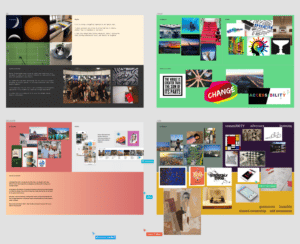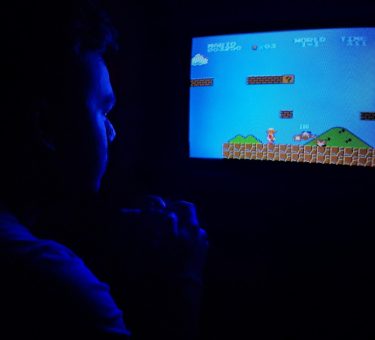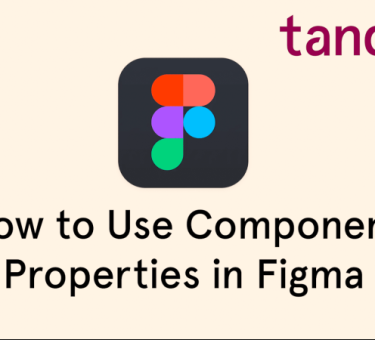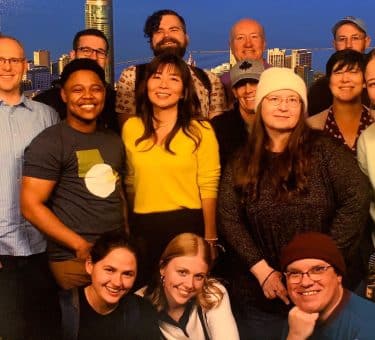At Tandem, our work style is highly collaborative–but this year, we haven’t been able to work together in person like we have in the past. Our transition to remote work has given us many opportunities to take a creative approach to our normal rituals, tools, and processes. Recently, Eli, Elizabeth, and Jewel planned a fully remote summit for Tandem’s team of design consultants.
Following the event, they sat down to discuss their experience planning a summit in the midst of the COVID-19 pandemic.
What were the goals of our design summit?
Elizabeth: Last year we had an off-site design summit in the spring. It was a chance to get away from our normal working environment, refresh and get to know each other in a different setting. Those themes still came into play when we were planning remotely: we wanted to connect, refresh, and come out of the summit with some action items. We wanted to get to know each other but also talk about some action items for our team and define what the design practice means to Tandem.
Eli: I was feeling like since we’re working remotely now, we need the summit even more. We’re a little more isolated now, mostly talking to the people on our project teams, so having the opportunity to come together and reflect and collaborate as a full design team was important.
Elizabeth: Half of our team joined Tandem during the pandemic! Even though we have all met online, we hadn’t had that intentional time to really get to know our design team members.
What did you have to take into consideration when planning an event during the COVID-19 pandemic?
Jewel: The three of us volunteered to organize the event, and first we started off by looking at the feedback from last year’s summit and putting together some high-level brainstorming around what this year’s could look like. As we dove in, we realized that we could use being remote to our advantage. We wanted to use it as a way of not only connecting with our team, but also connecting with ourselves, and our areas and communities outside of our house, away from our computers. So we came up with a theme: Design Citizenship–Creating For the World Outside Your Own.
As we started to build out the agenda, we thought other members of the team should lead each activity. It was important to our goal of connecting because the design summit wasn’t only for the three of us who planned it, it was for everybody–so we wanted everybody to feel involved.
Eli: That last point is really valuable: everybody had ownership over the summit. It wasn’t just us putting together content, it was everybody doing it together. We just created the framework. The theme worked well because it meant something meaningful but different to each of us.
Elizabeth: As we started to think about the theme, we took it to the team to get buy-in and make sure they were interested in spending two days of activities and conversation around it.
Jewel: Our agenda included a design citizenship moodboarding activity led by McKenzie, a discussion of Tandem’s prior design process led by Taher, and an inspiration walk where everybody went into their neighborhoods to take pictures of things that made them think of political/social/environmental issues. We then broke up into groups of two; working with teammates that we normally don’t work with, and used the pictures we took as the foundation to create new ideas that could better communicate an issue or create a solution for it, in a collaborative activity led by Eli. We also invited a guest speaker, Shannon Downey, who spoke about her work with craftivism.
Eli: We held the summit over two half-days so we didn’t overwhelm people with video calls. I had a lot of favorite parts, and walking around my neighborhood was one of them. Having a reason to go and be observant and be a listener around my neighborhood, I noticed things I hadn’t noticed before. It was inspiring.
Jewel: Even when we’re not working from home, most times when outside we’re on our phones, or in our own worlds, so it was really important to be intentional in observing our surroundings and what’s happening. This was therapeutic in a way; by delving into our communities and surroundings, we were not only physically present but mentally aware.
Elizabeth: Since doing that exercise, I’ve been more aware while walking my neighborhood. It’s not about the creative exercise anymore, but being more intentional and observant.
What tools helped enable the design summit?
Elizabeth: We used Figma, which is a collaborative working space, throughout the summit. We had pages for each activity which allowed the team to work within the same space and have an artboard where they could contribute. You could view each other’s artboards.

We also used FunRetro to do a retro board for our reflection activity at the end of the summit.
Jewel: We used Google Slides as a collaborative tool, to put together a presentation deck where we could communicate summit goals, agenda, activities, and overall have engaging visuals throughout the Design Summit.
What would you do differently next time?
Eli: Mostly just logistical things. We did a half day Wednesday and a half day Friday, and it was a little jarring to have Thursday in the middle. Scheduling the summit for one afternoon and the next morning might be a little better. In the future, we also want to build in more buffer time between activities. Keeping our schedule on track was kind of hard once everybody was invested and excited!
Jewel: I agree. Especially the first day, we didn’t have any breaks accounted for. The first half-day was an afternoon and we were trying to get through everything before 4:30, but everybody wanted five minutes between activities, so we’ll be sure to add buffer time to the schedule next time.
Eli: That seems especially true on video calls. Time to stand up, rest your eyes from the screen.
What action items did the Tandem design team come up with?
Elizabeth: Chris led a team goals exercise looking at six-month, one-year, and three-year goals. Each team member wrote down goals for each category, and we were heavily aligned with what those goals looked like. Some of those goals were:
- being involved in our community, and engaging with more projects within the Chicago tech community
- design education: how can we empower our teammates through learning material, conferences, or initiatives to help us learn things outside of our day-to-day work?
- Streamlining process and documentation
Eli: The activity that Taher led helped lead into that discussion too. It got us talking about our methods. Do we want to create our own design team kit? In our Design Crit last week, we created a plan of different ways the team could learn together going forward.
Jewel: Based on all the goals people suggested, we created action items. So the design toolkit, for example, will be a repository of all the methods, processes, and resources that we use as a team. We’re also creating a “learning corner” and design challenges where we can all be involved and learn new things every month. Now, we’re putting the action items into play.
What advice would you give to other people who are planning a remote summit for design teams?
Eli: Give ownership to everyone on the team while you’re planning and running it. Also, bringing in a guest speaker was great. Having an outside perspective really gave us a spark.
Elizabeth: The guest speaker wasn’t there to talk about our day-to-day work, but we could apply the core messages of what Shannon was saying to get a different perspective within our own role.
Jewel: I feel like the purpose of the summit was not only to get to know your team, but to get to know yourself even more. It’s easy for us to get consumed by our work. It’s harder to find time for yourself, to hear yourself think; to plan your own personal design goals. By working on the team goals together, I was able to structure some of my own. My advice is to have activities that connect you with your team and yourself. It becomes a holistic, inspirational experience and that’s my key takeaway.
Elizabeth: Jewel and Eli created an excellent set of Google slides with the agenda, the goals, and room for each person to add their activity’s content. That kept us on track and aligned to what we were doing.
Jewel: Having nice visuals helps build excitement for the event and makes it feel less like just another video meeting. If you go to an on-site summit, they have branding, signs, agenda, all sorts of visual collateral so we tried to offset the digital setting by making those visuals informative and engaging.
Eli: I’d also say having the three of us as a core group was important. We worked so well together and built off of each other’s ideas. We all had volunteered to plan the event, and we were good at splitting up responsibilities. It was logistical, but working together also kept our excitement and momentum moving forward.









